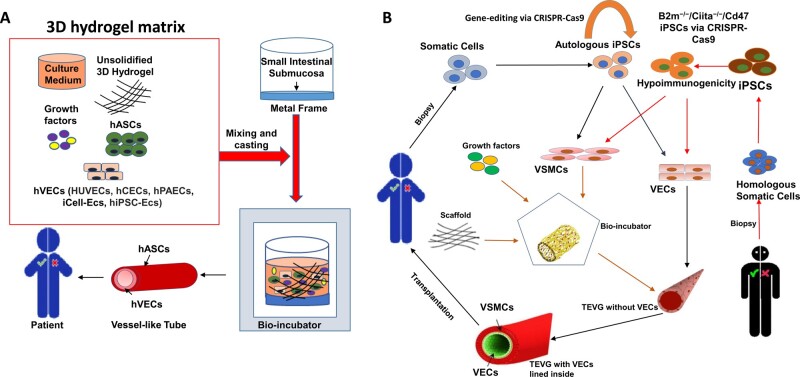Figure 3.
Strategies to manufacture tissue-engineered vascular graft (TEVG). (A) Co-culture of VECs and hASCs on de-cellularized small intestinal submucosa: VECs from five different sources (HUVECs, hCECs, hPAECs, iCell-ECs hiPSC-ECs) were co-cultured with hASCs under controlled stimuli (growth factors, 3D hydrogel) in bio-incubator, resulting in spontaneous formation of vascular network via self-organization. Importantly, VECs were surrounded by hASCs as mural cells, forming small calibre lumens within the 3D hydrogel. (B) iPSC-derived VSMCs and VECs: Somatic cells can be isolated either from patients themselves or from other healthy individuals and then reprogrammed into hiPSCs. For homologous hiPSCs, gene-editing tool (CRISPR-Cas9) enables acquisition of hypo-immunogenic hiPSCs (B2m−/−/Ciita−/−/Cd47). Afterwards, hiPSC-VSMCs were seeded onto a scaffold with appropriate stiffness and then transferred into bio-incubator, where proper temperature, mechanical stimulation, humidity, pH, and growth factors are controlled precisely to generate preliminary TEVG. Thereafter, hiPSC-VECs coated the lumen of preliminary TEVG to create the final TEVG which are ready for vascular grafting. EC, endothelial cells; hASCs, human adipose tissue-derived stromal cells; hCEC, human cardiac endothelial cell; hPAEC, human pulmonary artery endothelial cell; HUVECs, human umbilical vein endothelial cells; iCell-ECs, iPSC-derived endothelial cells from Cellular Dynamics International; VECs, vascular endothelial cells; VSMCs, vascular smooth muscle cells.

